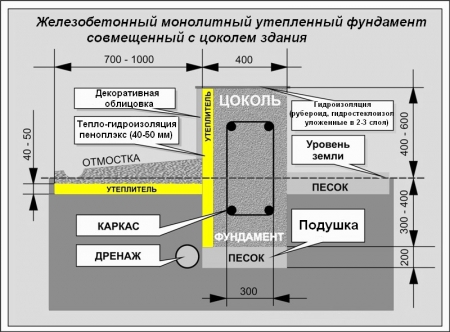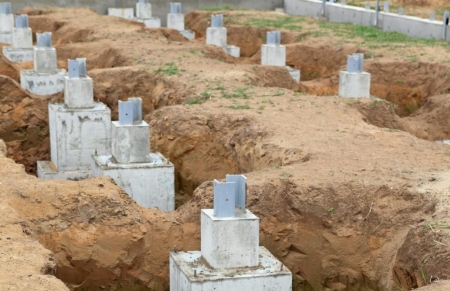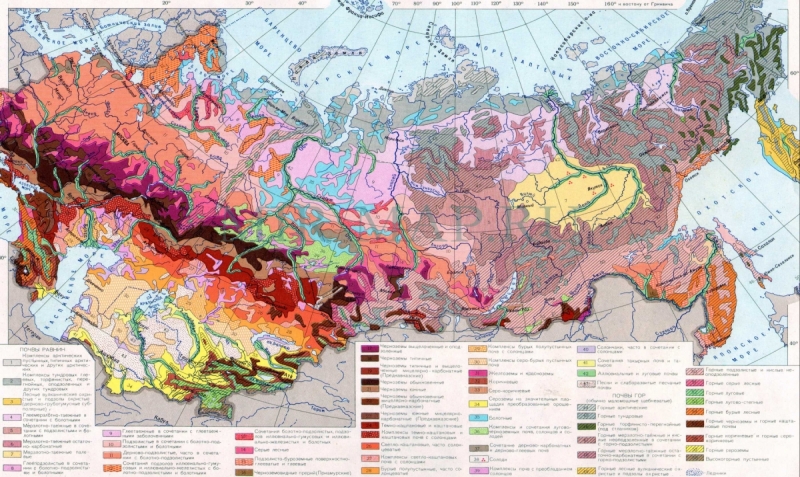Starting the repair in the bathroom, first evaluate its general condition. Sometimes...
|
|
It is not always possible to connect to a centralized water supply, so ... |
The efficiency of heating of any object of residential or industrial purposes is possible with ... |
Pillow for the foundation: Installation instructions

Different structures are different foundation. This must be taken as a given. The same foundation is not suitable for a garage, a country house or a high -rise building. Is it true? When choosing and calculating the foundation, it is necessary to know several basic rules and mandatory conditions for its laying. The foundation is the basis of the future structure and the life of the entire structure depends on its constructive characteristics. But in some cases, the foundation itself cannot be dispensed with without a reliable basis. Pilling a sandy and gravel pillow, how and for what types of foundations to use, we will try to figure it out.
Content
- Choosing the type of foundation
- Let's talk about soils
- What is a sand pillow?
- What is a sand pillow for? video
- Sanding a sand pillow for the foundation
Choosing the type of foundation
The main task of the foundation is the transfer and distribution of the load of the total weight of the structure to the ground. The choice of the type of foundation will depend on several main parameters: the weight of the structure, the depth of freezing of the soil, bearing the ability of the soil.
A frequent choice of an individual developer is monolithic reinforced concrete tape Ribbon foundation. The tape is designed and laid under all walls of future buildings, including internal partitions. There are two types of tape:
- wheeled strip foundation the depth of the laying below the freezing boundary of the soil by 200-300 mm;
- small-and-deep strip foundation The depth of the laying is not more than 400-500 mm, depending on the characteristics of the soil.
A fine -sized tape is used mainly on non -poudy, sandy and rocky soils, where good natural drainage is provided.
Another popular solution for individual construction is a bottle foundation. He is not afraid of moisture, durable. A large and main disadvantage of such a construction is the process of building such a foundation, it is very laborious. After all, the construction of this foundation provides for the fitting of each stone to each other, followed by fastening with their cement mortar.
A variety of missile foundation is brick foundation. It is characterized by lower strength characteristics and life, but lower the complexity of the work.
Block foundationmounted from finished reinforced concrete blocks, which are fastened together with cement mortar. It differs in the simplicity and speed of installation, but the high cost of the reinforced concrete of the blocks of blocks is not always appropriate during individual development.
Column foundationsthey are erected for small light buildings. The main building material for such houses is a tree. In some cases, such foundations are combined with the fiber advent of the ribbon, receiving pillars of the foundation. Such a foundation is more strength as strip, but lower cost.
Plaet foundationas a base, the whole plane under the house is used. A monolithic reinforced concrete stove is poured as the foundation. This type of foundation is used on highly fluffy soils and in an area where it is not a deep occurrence of groundwater.
The foundation on stilts Used for industrial construction, as well as the construction of multi -storey buildings.
The remaining types of foundation are the varieties of the above and contain their combinations.
Let's talk about soils
If the theater begins with a hanger, then the beginning of each construction begins with the choice of the place of the future structure. All subsequent choice and calculation of building materials will proceed from what soil on your site. Of course, if you need to build a small shed or a canopy for a car, then deep surveys about the soil on the site can be missed, but this cannot be not taken into account when erecting a house or other overall structure.
In accordance with GOST 25100-95, the soil is a multicomponent and diverse geological system, formed by rocks, soil, technogenic formations and is an object of engineering and economic life of a person.
Conditionally, soils are divided into two types: those that are frosty to fusion, and those on which frosty fusion has no effect. Depending on the type of soil on the site, the necessary measures should be taken for the optimal choice of the foundation.
We give a brief description to each type of soil:
- rock soils lie in the form of an array, have rigid structural connections, have great compression strength, do not freeze, waterproof, belong to a group of non -fluffy soils. Among them, it is necessary to highlight: granites, diorites, gneisses, quartzites, shales and others.
- do not rock soils that do not have tough ties, have particles of various sizes and are divided into:
- soils;
- biogenic;
- dusty-clay;
- sandy;
- large -sized;
Having determined what kind of soil on your site, you can start choosing a foundation.
Map of the soil of the Russian Federation
What is a sand pillow?
The sand pillow belongs to the group of artificial bases. It must be understood that a small layer of sand at the bottom of a trench or pit will not become a sand pillow. This is sandy preparation. Structurally sand pillow is much thicker than pushing. They are used to improve weak and subsidence soils, to replace the heaving soils with an undeveloped directly under the foundation. Their dimensions and form are constructed in each individual case.
What is a sand pillow for?
The sand pillow for the foundation performs several functions and they are different. In some cases, you can do without it, in some it is vital.
Alignment. Such a purpose of a sand pillow or adding one and the main ones. It should align the bottom of the trench or pit. The device of a sandy pillow for prefabricated foundations is mandatory. With a slab foundation, it is also necessary. Often, after the work of heavy construction equipment, the bottom of the pit wishes to be much better, aligning with sand will help save several cubic meters of concrete. Sand is somehow cheaper.
If the reinforced concrete tape is poured, the device of such a pillow is not necessary, since liquid concrete will fill all voids on their own. In this case, it is necessary to pay attention to other parameters, including soil.
Load distribution.Many unanimously repeat that the sand pillow redistributes the load, but where they do not indicate. The distribution of the load will be uniform both with it and without it. Such a pillow is nevertheless used not to distribute the load on the soil, but to reduce it, as well as to protect against possible temporary submarines of the soil. Sand in this case compensates for these movements. Replacing weak and fluffy soils with sand, we increase the bearing capacity of the soil providing a reliable base.
Drainage function.With the thickness of the sand from 300mm, capillary connections in the ground are destroyed, which is opposed to raising moisture from the soil to the foundation. Also, moisture during precipitation is assigned below the level of the foundation. In this case, it is necessary to provide for the possibility of a sandy pillow drainage.
Frosty protection. Since the sand removes water well, it is used to replace the heaving soil, thereby providing protection against fusion and stabilization of the structure. But it should be remembered that for this design it is necessary to organize drainage, otherwise the moisture in the sand will only aggravate the situation.
Sanding a sand pillow for the foundation
The calculation of the thickness of the sand pillow must be carried out based on the parameters of the future structure and the characteristics of the soil of this site. Many do not use it at all. Solve only to you.
The sand pillow belongs to the underlying layer. As raw materials, medium and coarse sand are used, and gravel can also be used. For slab foundations, two pillows are arranged one of the sand, the second of the crushed stone.
The pillow must be protected from possible siltation with soil waters. When sulfenting the pillow, it turns into ordinary heaving soil with all the ensuing consequences. Such protection of the pillow is perfectly provided by geotextiles.
The order of backfill of the sand pillow:
- The bottom of the trench is covered with geotextiles. At the same time, on each side it is necessary to leave the edge width to close the pillow on the side and from above.
- Pour the necessary thickness of the sand pillow
- Trump the sand
- Close the pillow with geotextiles. If devices are planned with a gravel pillow, pour a layer of sand 50 mm to prevent geotextile damage.
Such simple measures for the arrangement of a sand pillow. But it is better to ask a professional about the feasibility of its application.










